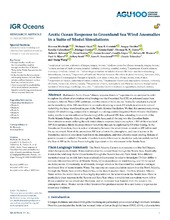| dc.contributor.author | Muilwijk, Morven | |
| dc.contributor.author | Ilicak, Mehmet | |
| dc.contributor.author | Cornish, Sam B. | |
| dc.contributor.author | Danilov, Sergey | |
| dc.contributor.author | Gelderloos, Renske | |
| dc.contributor.author | Gerdes, Rüdiger | |
| dc.contributor.author | Haid, Verena | |
| dc.contributor.author | Haine, Thomas W.N. | |
| dc.contributor.author | Johnson, Helen L. | |
| dc.contributor.author | Kostov, Yavor | |
| dc.contributor.author | Kovács, Tamás | |
| dc.contributor.author | Lique, Camille | |
| dc.contributor.author | Marson, Juliana M. | |
| dc.contributor.author | Myers, Paul G. | |
| dc.contributor.author | Scott, Jeffery | |
| dc.contributor.author | Smedsrud, Lars H. | |
| dc.contributor.author | Talandier, Claude | |
| dc.contributor.author | Wang, Qiang | |
| dc.date.accessioned | 2019-11-19T09:15:44Z | |
| dc.date.available | 2019-11-19T09:15:44Z | |
| dc.date.issued | 2019-08-04 | |
| dc.Published | Muilwijk MK, Ilicak M, Cornish, Danilov S, Gelderloos R, Gerdes R, Haid, Haine TW, Johnson HL, Kostov, Kovács, Lique C, Marson, Myers, Scott, Smedsrud LH, Talandier C, Wang Q. Arctic Ocean Response to Greenland Sea Wind Anomalies in a Suite of Model Simulations. Journal of Geophysical Research - Oceans. 2019;124(8). | eng |
| dc.identifier.issn | 2169-9291 | en_US |
| dc.identifier.issn | 2169-9275 | en_US |
| dc.identifier.uri | https://hdl.handle.net/1956/21006 | |
| dc.description.abstract | Plain Language Summary: The North Atlantic Current is an extension of the Gulf Stream, which brings warm Atlantic Water northward as the current flows through the Nordic Seas. Eventually, it enters the cold deep Arctic Ocean basins through the Barents Sea and Fram Strait. Nine different numerical ocean ice models have been analyzed and compared in order to investigate (1) their ability to simulate this northward flow of Atlantic Water, (2) its dependence on wind forcing, and (3) its impact on Arctic sea ice. Consistently, in all models, stronger winds in the Greenland Sea result in a stronger northward flow of warm Atlantic Water. The response on ocean circulation occurs from the North Atlantic, through the Nordic Seas and the Barents Sea, to the deep Canadian Basin. The flow of warm Atlantic Water within the Arctic Ocean is thus highly dependent on the wind stress in the Nordic Seas. There is particularly clear response in the Barents and Kara Seas where a wind‐driven anomalous warm inflow drives a smaller sea ice extent and thickness, and an increased heat transfer from the ocean to the atmosphere above. Weaker winds in the Greenland Sea produces weaker flow and hence a larger sea ice extent and thickness. | en_US |
| dc.description.abstract | Abstract: Multimodel Arctic Ocean “climate response function” experiments are analyzed in order to explore the effects of anomalous wind forcing over the Greenland Sea (GS) on poleward ocean heat transport, Atlantic Water (AW) pathways, and the extent of Arctic sea ice. Particular emphasis is placed on the sensitivity of the AW circulation to anomalously strong or weak GS winds in relation to natural variability, the latter manifested as part of the North Atlantic Oscillation. We find that anomalously strong (weak) GS wind forcing, comparable in strength to a strong positive (negative) North Atlantic Oscillation index, results in an intensification (weakening) of the poleward AW flow, extending from south of the North Atlantic Subpolar Gyre, through the Nordic Seas, and all the way into the Canadian Basin. Reconstructions made utilizing the calculated climate response functions explain ∼50% of the simulated AW flow variance; this is the proportion of variability that can be explained by GS wind forcing. In the Barents and Kara Seas, there is a clear relationship between the wind‐driven anomalous AW inflow and the sea ice extent. Most of the anomalous AW heat is lost to the atmosphere, and loss of sea ice in the Barents Sea results in even more heat loss to the atmosphere, and thus effective ocean cooling. Release of passive tracers in a subset of the suite of models reveals differences in circulation patterns and shows that the flow of AW in the Arctic Ocean is highly dependent on the wind stress in the Nordic Seas. | en_US |
| dc.language.iso | eng | eng |
| dc.publisher | American Geophysical Union | en_US |
| dc.rights | Attribution CC BY 4.0 | eng |
| dc.rights.uri | http://creativecommons.org/licenses/by/4.0/ | eng |
| dc.title | Arctic Ocean Response to Greenland Sea Wind Anomaliesin a Suite of Model Simulations | en_US |
| dc.type | Peer reviewed | |
| dc.type | Journal article | |
| dc.date.updated | 2019-09-12T18:10:08Z | |
| dc.description.version | publishedVersion | en_US |
| dc.rights.holder | Copyright 2019 The Authors | en_US |
| dc.identifier.doi | https://doi.org/10.1029/2019jc015101 | |
| dc.identifier.cristin | 1724216 | |
| dc.source.journal | Journal of Geophysical Research - Oceans | |
| dc.identifier.citation | Journal of Geophysical Research - Oceans. 2019, 124 (8), 6286-6322. | |

